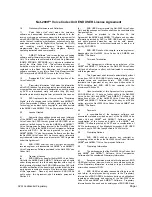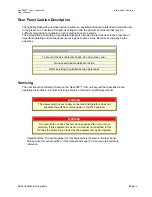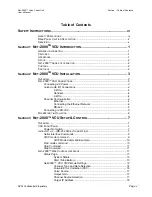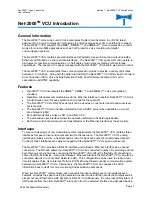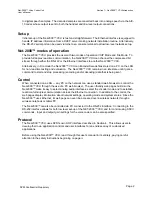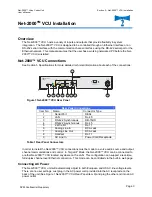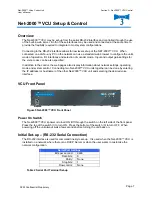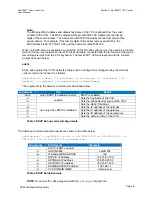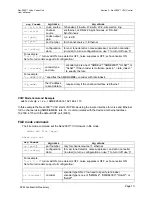
Net-2000™ Voice Codec Unit
User’s Manual
DVSI Confidential Proprietary
Page iii
Information – Section
Safety Instructions
Safety Precautions
1. Read Instructions - All the safety and operating instructions should be read before operating the
Net-2000™ VCU unit. Failure to exercise reasonable care and to follow all instructions and heed
all warnings may result in injury to property or to individuals.
2. Retain Instructions - The safety and operating instructions should be retained for future reference.
3. Heed Warnings - Adhered to all warnings and cautions on the unit and in the operating
instructions.
4. Follow Instructions - All operating and use instructions should be followed.
5. Water and Moisture - The appliance should not be used near water - for example, near a
washbowl, sink, laundry tub, or in a wet or damp location. Moisture may form inside the unit it is
brought from cool surroundings into a warm room or if the room temperature suddenly rises. To
prevent this, let the Net-2000™ VCU unit stand in its new surroundings for about an hour before
switching it on, or make sure the room temperature rises gradually. Condensation may also form
if the unit is exposed to the breeze from an air conditioner. In these situations, change the
location of the Net-2000™ VCU .
6. Carts and Stands - The Net-2000™ VCU unit should be used only with a cart or stand that is
suitable for the units size and weight. The unit and cart combination should be moved with care.
Quick stops, excessive force, and uneven surfaces may cause the cart to overturn.
7. Wall or Ceiling Mounting - The Net-2000™ VCU unit is not intended to be mounted to a wall or
the ceiling.
8. Ventilation - The Net-2000™ VCU unit should be situated so that its location or position does not
interfere with proper ventilation and air circulation around the unit. For example, the unit should
also not be placed in a built-in installation, such as an sealed cabinet or bookcase that may
impede the flow of air around the unit.
9. Heat - The Net-2000™ VCU unit should be situated away from heat sources such as radiators,
heat registers, ovens, or other appliances (including amplifiers) that produce heat.
10. Power Sources - The Unit should be connected to an AC power source only of the type
described in the operating instructions or as marked on the Net-2000™ VCU unit. The Net-
2000™ VCU unit uses AC voltages which can cause death or serious injury if used improperly.
Extreme care must be taken when connecting or disconnecting from power sources and in no
event should the user remove the cover or back of the unit.
11. Grounding and Polarization - Precautions should be taken to insure that the grounding or
polarization means of the Net-2000™ VCU unit is not defeated.
12. Power-Cord Protection - Power-supply cords should be routed so that they are not likely to be
walked on or pinched by items placed upon or against them. Pay particular attention to cords at
plugs, convenience receptacles, and the point where they connect to the Net-2000™ VCU unit.
Handle the power-cord by the plug. Do not pull out the plug by tugging the cord.
13. Cleaning - Unplug the Net-2000™ VCU unit from the AC power source before cleaning. The unit
should be cleaned only with a polishing cloth or soft dry cloth. Never clean the unit with furniture
wax, benzene, insecticides, or other volatile liquids.
14. Nonuse Periods - The AC power cord of the Net-2000™ VCU unit should be unplugged from the
wall outlet when left unused for long periods of time.
15. Object and Liquid Entry - Care should be take so that objects do not fall and liquids are not
spilled onto the enclosure.
16. Damage Requiring Service - The Net-2000™ VCU unit should be serviced by qualified service
personnel when:
•
The power-supply cord or plug has been damaged.
•
Objects have fallen, or liquid has been spilled into the unit; or
•
The unit has been exposed to rain; or
•
The unit does not appear to operate normally or exhibits a marked change in performance;
or
•
The unit has been dropped, or the enclosure damaged.



